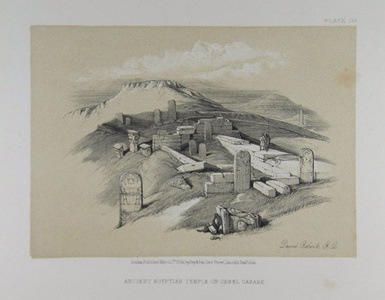| Method | Lithograph with tint stone |
| Artist | after David Roberts |
| Published | London, Published March. 1st 1856, by Day & Son, Gate Street, Lincoln's Inn Fields |
| Dimensions | Image 126 x 178 mm, Sheet 205 x 285 mm |
| Notes |
Plate 119 from Volume 3 of the small format reprint of Roberts' The Holy Land, Syria, Idumea, Arabia, Egypt & Nubia. A view of the ancient Egyptian Temple of Hathor at Gebel Garabe, usually known as Serabit el-Khadim, in the Sinai, Egypt. The ancient town grew around the turquoise mines in the region, which inscription evidence discovered by Sir Flinders Petrie suggests was manned largely by Northern Semitic prisoners of war. Considering the close proximity of the site to Mount Sinai, it has been suggested that the 'Golden Calf' idol crafted by the Hebrews during Moses' absence may be a reference to the goddess Hathor, who was often depicted zoomorphically as a cow. Roberts' view of the site shows a number of Egyptian stelae amongst the temple foundations, as well as a colossal column capital featuring the distinctive Hathor-head pattern depicting the goddess with bovine ears and heavy plaited hair. A Bedouin man rests against the top of this fallen capital, while two of his fellows stand of the temple foundations. David Roberts RA (24th October 1796 – 25th November 1864) was a Scottish painter. He is especially known for a prolific series of detailed prints of Egypt and the Near East produced during the 1840s from sketches made during long tours of the region (1838-1840). This work, and his large oil paintings of similar subjects, made him a prominent Orientalist painter. He was elected as a Royal Academician in 1841. The firm of Day & Haghe was one of the most prominent lithographic companies of the nineteenth-century. They were also amongst the foremost pioneers in the evolution of chromolithography. The firm was established in 1823 by William Day, but did not trade under the moniker of Day & Haghe until the arrival of Louis Haghe in 1831. In 1838, Day & Haghe were appointed as Lithographers to the Queen. However, and perhaps owing to the fact that there was never a formal partnership between the two, Haghe left the firm in the 1850's to devote himself to watercolour painting. The firm continued as Day & Son under the guidance of William Day the younger (1823 - 1906) but, as a result of a scandal involving Lajos Kossuth, was forced into liquidation in 1867. Vincent Brookes bought the company in the same year, and would produce the caricatures for Gibson Bowles' Vanity Fair magazine, as well as the illustrations for Cassells's Poultry Book, amongst other commissions. Condition: Light foxing to margins, not affecting image. |
| Framing | unmounted |
| Price | £30.00 |
| Stock ID | 39023 |

